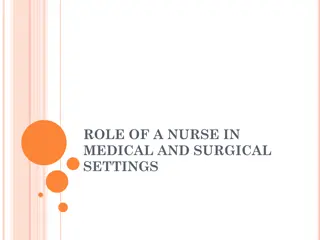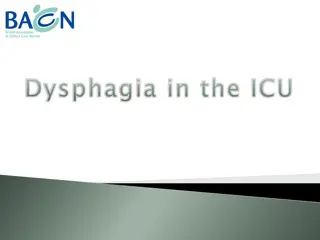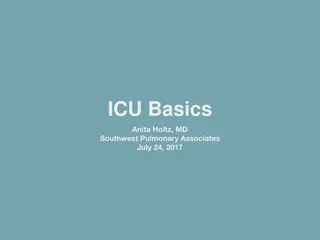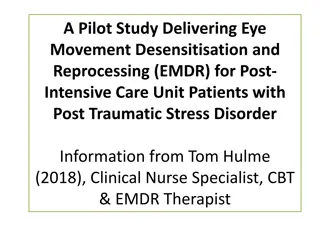Comprehensive ICU Protocol for Sedation, Analgesia, and Delirium Control by Dr. Vinod Srivastava
This comprehensive ICU protocol by Dr. Vinod Srivastava, an Associate Professor in Anaesthesiology & Critical Care at KGMU, covers key aspects such as sedation, analgesia, delirium assessment and control, stress ulcer and deep vein thrombosis prophylaxis, and glycaemic control in the ICU setting. Th
3 views • 50 slides
Guidelines for Intensive Care Unit (ICU) Management by Dr. Zia Arshad
Dr. Zia Arshad provides comprehensive guidelines for managing patients in the ICU, including admission criteria, monitoring protocols, handling lab investigations, communication procedures, and post-mortem care. The guidelines emphasize meticulous documentation, compassionate patient care, infection
0 views • 28 slides
Antibiotic Therapy in the ICU: Strategies and Considerations
Delve into the world of antibiotic therapy in the intensive care unit (ICU) with a focus on identifying the enemy pathogens, selecting the appropriate antibiotics, and formulating effective treatment plans. Explore the nuances of Gram-positive and Gram-negative bacteria, along with other key bacteri
6 views • 76 slides
Fluid Management in ICU: Understanding Body Fluid Compartments and Types of Fluids
Fluid management in the ICU is crucial for patient care. This includes understanding the distribution of body fluid compartments, such as intravascular, interstitial, and intracellular fluids. Different types of fluids like crystalloids and colloids play essential roles in treatment. Crystalloids ar
4 views • 26 slides
Nursing Care for Ventilator-Associated Pneumonia (VAP)
Ventilator-Associated Pneumonia (VAP) is defined as lung parenchyma inflammation occurring 48 hours or more after endotracheal intubation and mechanical ventilation initiation. It is a common nosocomial infection in ICU patients, with significant morbidity and mortality rates. Etiology of VAP involv
2 views • 24 slides
Quick MD Care_ Your Trusted Partner in Primary Care Medicine
Quick MD Care: Your Trusted Partner in Primary Care Medicine\n\nWelcome to Quick MD Care, where compassionate primary care meets convenience. We understand the importance of having a trusted partner in managing your health. Our team of dedicated primary care doctors is committed to providing persona
5 views • 2 slides
Improving Patient Safety in our Hospitals
Dr. Sarah McMullen discusses the importance of early recognition and treatment of clinical deterioration in hospital settings to improve patient outcomes. Key points include identifying abnormal clinical antecedents, implementing early warning systems like NEWS2 and CHEWS, screening patients for cri
3 views • 35 slides
Primary Care Services: Comprehensive Health Management for Everyone
Primary Care Services: Comprehensive Health Management for Everyone\n\nPrimary care services are the foundation of a robust healthcare system, ensuring that individuals have access to comprehensive, continuous, and coordinated care. These services are typically provided by primary care medical cente
3 views • 2 slides
Role of a Nurse in Medical and Surgical Settings
The primary role of a nurse in medical and surgical settings is to provide direct care to adult patients in various healthcare facilities such as hospitals, clinics, homes, and surgical centers. Nurses play a crucial role in outpatient departments (OPD), inpatient departments (IPD), intensive care u
0 views • 16 slides
Sleep Patterns and Architecture in the ICU Setting
Sleep in the ICU is crucial for physiological rest and emotional well-being, but it is often disrupted due to various factors. Normal sleep architecture consists of REM and Non-REM sleep cycles, each vital for different restorative processes. Non-REM sleep has three stages, including deep sleep impo
0 views • 25 slides
Palliative Care: Enhancing Quality of Life in Serious Illness
Palliative care is a holistic approach focused on improving the quality of life for patients and their families dealing with life-threatening illnesses. It involves early identification, assessment, and treatment of pain and other physical, emotional, and spiritual issues. This comprehensive trainin
1 views • 60 slides
Ward Management in Healthcare Settings
Ward management involves optimizing resources in a ward to provide maximum care and comfort to patients. It includes functions like accommodation, treatment, recovery support, training opportunities, and research possibilities. Different types of wards exist, such as general wards and specific wards
2 views • 25 slides
Child Care and Youth Programs at Minot AFB
Offering a range of child care services including Child Development Center for ages 6 weeks to 5 years, School Age Care for Kindergarten to 12 years, Family Child Care Program, and Youth Programs for ages 9-18. Services include full-time care, before/after school care, extended duty care, emergency
2 views • 6 slides
Enhancing Palliative Care in Australian Residential Aged Care
PACOP, funded by the Australian Government Department of Health and Aged Care, is a program focused on improving palliative care in residential aged care facilities. It involves standardized assessment practices, early identification of care needs, and a collaborative model for sustainable support.
0 views • 10 slides
Nutritional Considerations for Chronic Liver Disease in Critical Care
Malnutrition is common in chronic liver disease, leading to complications such as ascites and infections. Sarcopenia and weight loss are prevalent regardless of BMI. Critical care patients with liver disease face challenges due to limited physiological reserve, with main causes for ICU admission bei
1 views • 17 slides
Case Study: Management of Haemothorax Complicated by Pneumonia in a 62-Year-Old Patient
A 62-year-old patient with a history of COPD, AF, and metallic AVR on warfarin presented with left-sided chest pain and breathlessness. Initially diagnosed with a pleural effusion, subsequent imaging revealed a complicated parapneumonic effusion/empyema. Despite initial drainage and treatment, the p
0 views • 19 slides
Priorities and Quality Measures for Type 2 Diabetes Care in NHS GGC
Dr. Kashif Ali leads primary care for Type 2 diabetes, while Dr. James Boyle oversees secondary care in NHS GGC. The data from December 2018 shows the number of Type 2 diabetes patients, their care processes, HbA1c levels, and BMI status. The Diabetes Quality Improvement and Outcome Measures aim to
0 views • 27 slides
Dysphagia in the ICU: Assessment and Impact
Dysphagia, the difficulty in swallowing, is a common issue in the ICU, affecting a significant percentage of intubated patients. It increases mortality, risk of pneumonia, malnutrition, and prolongs hospital stays. Assessment methods like bedside evaluation and FEES are crucial in managing dysphagia
5 views • 8 slides
Child Care Challenges in Kentucky: The Child Care Cliff
Explore the landscape of child care in Kentucky, revealing the challenges families face with the Child Care Cliff. Discover statistics on child care centers, family child care homes, and the average cost of child care in Kentucky. Understand the importance of the Child Care Assistance Program (CCAP)
0 views • 18 slides
Sedation, Analgesia, and Paralytics in the ICU: A Comprehensive Guide
This comprehensive guide delves into the use of sedatives, analgesics, and paralytics in the intensive care unit (ICU). It covers various medications like Etomidate, Propofol, Ketamine, Benzodiazepenes, and Dexmedetomidine, detailing their indications, dosages, and effects. Understanding the role of
0 views • 21 slides
Critical Cardiac Arrest Patient Nursing Scenario
In this scenario, you are starting your shift in the ICU with a critical cardiac arrest patient, Jack Prescott, a 56-year-old male. The learning objectives include recognizing septic patient symptoms, assessing hemodynamic status, initiating communication with a physician, and developing a care plan
0 views • 12 slides
Essential Tips for ICU Rotations
Prepare for your ICU rotation with these essential tips: read the orientation packet, educate yourself with original articles, prioritize patient stability, know your care team, and focus on learning and growth as an intern or resident. Be ready to identify sick patients, understand disease processe
0 views • 33 slides
Bringing Life Through Organ Donation: Two-Week Action Plan
Over the next two weeks, the Gift of Life aims to refocus on connecting with palliative care teams, educate ICU staff on the importance of early referrals, raise awareness in the Caribbean community about organ donation, coordinate information sessions with OPO liaisons, and encourage colleagues to
0 views • 64 slides
Stress Ulcer Prophylaxis in ICU - Adverse Reactions Reporting Guidelines
Guidelines for reporting adverse reactions in Stress Ulcer Prophylaxis in the Intensive Care Unit (SUP-ICU), including definitions of Adverse Reactions (AR), Serious Adverse Reactions (SAR), Adverse Events (AE), Serious Adverse Events (SAE), SARs in SUP-ICU, and SUSARs. Specific conditions considere
0 views • 8 slides
Minot Air Force Base Family Child Care Programs
Offering a variety of child care services including Child Development Center (CDC) for infants to 5 years old, School Age Care (SAC) for Kindergarten to 12 years, Youth Programs for ages 9-18, and Family Child Care Program (FCC) for infants to 12 years. Additional programs include Extended Duty Care
0 views • 6 slides
Impacts of Marketisation on Home Care for Older People in Urban China
This study by Wenjing Zhang from the University of Bristol delves into the effects of the marketisation process on home care for the elderly in urban China. It explores the rationale behind the marketisation of care, the trends in home care marketisation, and the processes involved. The background s
0 views • 19 slides
Impact of Physiotherapy on ICU Patients: A Comprehensive Study
Investigating the impact of physiotherapy interventions on ICU patients, this study reveals findings on muscle weakness, reduced mobility, chronic pain incidence, and referral patterns post-ICU discharge. The study aims to improve patient outcomes through tailored interventions and follow-ups.
0 views • 11 slides
Kidney Injury and Liver Disease in the ICU
This presentation delves into the intricacies of acute kidney injury (AKI) and its occurrence in patients with liver disease in the intensive care unit (ICU). It covers the definitions, classifications, and causes of AKI, emphasizing the Hepatorenal Syndrome, a form of functional renal failure in en
0 views • 29 slides
Role of Organ Donation Fellows in Intensive Care Units
Organ Donation Fellows (ODFs) are experienced doctors specializing in deceased organ donation, spending time on the ICU rota and supporting organ donation activities. They assist in donor optimization, communication with families, and organ retrieval, benefiting both ICU patients and the healthcare
0 views • 4 slides
Common Equipment and Systems in ICU
Common equipment in an ICU includes mechanical ventilators, cardiac monitors, monitoring equipment for bodily functions, and a variety of tubes, lines, and pumps. Drugs like analgesics are used to reduce pain and prevent infections. Monitors track heart rate, blood pressure, and temperature, while t
0 views • 48 slides
Step-Wise Approach in ICU Management of a Patient in Respiratory Distress
An intensivist outlines a systematic approach for managing an acutely unstable patient in respiratory distress in the ICU. The process includes clinical assessment, noninvasive ventilation options, considerations for vital organ functions, and potential pitfalls to avoid. Emphasis is placed on diffe
0 views • 52 slides
ICU Education Experience in London During COVID Pandemic
Survey results of doctors redeployed to ICU in London reveal the London Transformation & Learning Collaborative (LTLC) program aims to enhance staff preparedness, share best practices, and improve patient outcomes through consistent training and collaboration. The LTLC program focuses on increasing
0 views • 20 slides
ABCDE Protocol and MIND-USA: Enhancing Critical Care Practices
Explore the importance of the ABCDE Protocol in managing ICU patients, focusing on sedation, analgesia, and the prevention of delirium. Learn about the potential drawbacks of sedative therapies and the need for coordinated care in critical care settings. Discover the MIND-USA ABCDE Protocol, emphasi
0 views • 43 slides
Subacute Care: Types of Residents and Care Settings
Subacute care involves providing specialized care for individuals who require more attention than what typical long-term care facilities can offer. This level of care is provided in settings like hospitals or certain units within long-term care facilities. Residents in subacute care settings need a
0 views • 62 slides
Delivering EMDR for PTSD in Post-ICU Patients: A Pilot Study by Tom Hulme
More ICU survivors are experiencing PTSD post-discharge. Symptoms include intrusive thoughts, nightmares, avoidant behavior, and hypervigilance. EMDR therapy is recognized as effective. This pilot study aims to provide evidence-based treatment to improve health outcomes in this patient group.
0 views • 10 slides
Nutritional Therapy in the ICU: Enteral and Parenteral Nutrition Overview
Nutrition is crucial in ICU care to provide adequate calories and protein for patients. This involves enteral nutrition via tubes and parenteral nutrition through IV solutions. Enteral feeding should begin within 24-48 hours if the GI tract is functional, while parenteral nutrition includes dextrose
1 views • 13 slides
Evolution of Intensive Care Units: From Harvey Cushing to Modern Healthcare
Intensive care units (ICUs) have evolved through the meticulous practices of pioneers like Harvey Cushing, who emphasized post-operative care and infection control. As surgical procedures advanced, ICUs became crucial in saving lives during critical medical conditions. From reducing mortality rates
0 views • 23 slides
ICU Education Experience Across London During COVID Pandemic Survey Results
Explore the outcomes of the London Transformation & Learning Collaborative (LTLC) program focusing on enhancing critical care staffing and education in response to the COVID-19 pandemic. The initiative aims to cross-skill staff, expand ICU capacity, and optimize workforce capabilities to manage curr
0 views • 19 slides
Overview of ICU Admission and Management for Critically Ill COVID-19 Patients
There are various strains of coronavirus with Sars-cov-2 causing COVID-19. The virus is transmitted through droplets and has an incubation period of 2-14 days. Clinical features range from mild illness to critical disease with a fatality rate of 2.3-5%. Criteria for ICU admission include the need fo
0 views • 27 slides
Stress Ulcer Prophylaxis in ICU Data Entry System - SUP-ICU Overview
Dive into the Stress Ulcer Prophylaxis in the Intensive Care Unit (SUP-ICU) data entry system led by Dr. Soeren Marker Jensen. Explore screening, randomization, site overview, and data entry processes. Access participant details, edit submitted data, and learn about data entry guidelines. Enter the
0 views • 28 slides







































